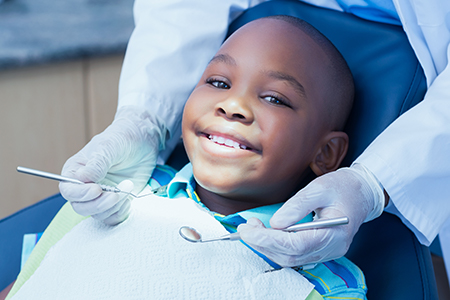
At the office of Brilliant Dental of Salem, the health and growth of your child’s smile are central to everything we do. We focus on prevention, education, and compassionate care so children and families can build strong dental habits that last a lifetime.

Healthy adult smiles begin with early attention to baby teeth and daily routines. A consistent brushing and flossing habit introduced at an early age sets expectations for self-care and reduces the chance of decay as permanent teeth arrive. We emphasize small, doable steps parents can use to make oral care part of the household routine.
Preventive visits are not just about checking for cavities — they are opportunities to watch how your child’s mouth is developing, answer questions about feeding and teething, and give tailored guidance on toothbrushing technique, toothpaste use, and when to start independent brushing. Early positive experiences with dental care also help children feel confident and less anxious about future visits.
Our team takes a practical, family-centered approach: we coach parents, demonstrate safe techniques, and recommend age-appropriate tools so oral care is effective and manageable. The aim is to build habits that protect teeth, support nutrition, and promote overall comfort with dental care throughout childhood.

Regular checkups allow the dental team to catch small problems before they become bigger concerns. During routine exams we evaluate tooth eruption, monitor bite development, and screen for early signs of decay or enamel wear so that treatment — when needed — can be less invasive and more effective.
Professional cleanings remove buildup in hard-to-reach areas and provide a hands-on chance to refine a child’s home care routine. When appropriate, we recommend minimally invasive preventive treatments such as fluoride varnish or sealants to protect vulnerable chewing surfaces.
These visits also provide the setting for practical conversations about diet, sleep habits, pacifier use, and other behaviors that influence dental health. Our goal is to give families clear, actionable steps they can follow between appointments to reduce risk and support steady development.
Tooth decay remains one of the most common chronic conditions in children, but it is largely preventable. Decay develops when sugary residues and bacteria remain on teeth; young children can be particularly vulnerable because they may not yet have the coordination or attention span for effective cleaning.
We take a collaborative approach with caregivers to reduce risk: teaching safer bottle and sippy-cup practices, recommending timing and types of snacks, and offering strategies to replace high-sugar drinks with water. Small changes in daily routines often make a big difference in oral health outcomes.
Where decay appears, we prioritize conservative, child-friendly treatment to preserve tooth structure and comfort. Our clinical choices are guided by the child’s needs, developmental stage, and the goal of keeping visits calm and predictable.
Parents often ask for straightforward advice they can actually use. For infants and toddlers, wiping gums after feedings and using a soft, damp cloth or infant toothbrush for newly erupted teeth reduces bacteria and establishes a habit. Once children can spit reliably, a smear of fluoride toothpaste and supervised brushing twice daily becomes the norm.
We also help families create routines that make brushing enjoyable: short timers, favorite songs, and positive reinforcement can make the difference between hurried attempts and consistent care. As children grow, we gradually transfer responsibility while monitoring technique and thoroughness.
Nutritional choices are part of daily care. We encourage balanced meals and healthy snacks, limit sticky sweets, and suggest water as the primary drink between meals. These small decisions lower cavity risk and support overall growth.
Tooth development begins long before the first tooth appears. By about six months many infants show their first primary teeth, and the American Academy of Pediatric Dentistry recommends a dental visit by the child’s first birthday or within six months of the first tooth erupting. Early visits allow us to assess growth and give parents the tools they need from the start.
Teething can be uncomfortable but is typically manageable with gentle comfort measures — chilled teething rings, soft cloths, and calming routines. If symptoms seem severe or are accompanied by other concerning signs, we’re available to evaluate and advise.
These early appointments focus on prevention and education. We discuss bottle and sleep routines that protect developing teeth, review safe oral care practices, and outline what to expect as teeth erupt so parents feel informed rather than worried.
Children and teens lead busy, active lives. For young athletes, a properly fitted mouthguard is a simple, effective way to reduce the risk of dental trauma. We provide guidance on mouthguard options and fit so families can choose the best protection for their child’s sport and level of participation.
Habits like thumb-sucking or prolonged pacifier use are common, and most children stop on their own. If these behaviors persist past early childhood and begin to affect tooth alignment or speech, we discuss positive, age-appropriate strategies to help children transition away from those habits.
We also watch facial growth and tooth alignment during routine exams so potential orthodontic needs are identified early. Many alignment issues are easier to address when detected during growth, and we’ll advise families about appropriate timing for specialist consultations when warranted.
Accidents and sudden dental pain can be frightening for children and families. Common emergencies include chipped or displaced teeth, severe toothaches, and soft-tissue injuries. Our team is experienced in responding calmly and efficiently to stabilize the situation, relieve discomfort, and determine next steps.
Immediate attention often reduces long-term consequences. We prioritize safe, evidence-based approaches that protect oral health and reduce anxiety for the child, with follow-up care planned to restore form and function as needed.
Successful pediatric dental care blends clinical expertise with clear communication and partnership with parents. We strive to create a welcoming environment where children feel comfortable and families receive straightforward, practical advice tailored to their child’s stage of development.
Our focus is on prevention, early detection, and minimally invasive care designed to preserve healthy teeth and foster confidence. When treatment is needed, we explain options in plain language so families can make informed choices that reflect their child’s needs and temperament.
We understand that every child is different; our care reflects that individuality while relying on proven guidelines and modern techniques to support healthy growth and a positive relationship with dental care.
Start cleaning the mouth soon after birth and introduce brushing as the first teeth appear.
Limit sugary drinks and snacks, and encourage water between meals.
Bring children for routine dental visits beginning around the first birthday and continue on a regular schedule.
Use protective gear — like mouthguards — for organized sports and active play.
Model good oral hygiene: children learn by watching caregivers follow consistent routines.

Brilliant Dental of Salem is committed to providing thoughtful, age-appropriate pediatric dentistry that helps children grow into confident, healthy smiles. If you have questions about visits, prevention strategies, or any aspect of your child’s dental care, please contact us for more information.

The American Academy of Pediatric Dentistry recommends a dental visit by the child’s first birthday or within six months of the first tooth erupting. Early visits let the team assess growth, discuss feeding and teething concerns, and introduce families to effective cleaning routines. Starting visits early also helps children become familiar with the dental environment and reduces anxiety about future care.
At the first appointment the focus is primarily preventative and educational rather than treatment-oriented, so parents leave with practical steps they can use at home. We review daily care, safe bottle and sippy-cup practices, and expectations for tooth eruption. Regular checkups from infancy onward make it easier to identify emerging needs and keep development on track.
Preparation begins with a calm, age-appropriate conversation about what will happen at the visit and why oral care matters. Use simple, positive language, read a book about visiting the dentist, and role-play sitting in the dental chair to make the experience predictable. Avoid using the appointment as a threat or surprise; instead frame it as a normal part of keeping a healthy smile.
On the day of the visit bring any comfort items your child uses and arrive a little early to allow time to settle in. Share relevant medical history and feeding habits with the team so they can tailor their approach. If a child has special needs or strong dental anxiety, let the office know in advance so staff can plan extra support and accommodations.
Good home care combined with regular professional visits forms the foundation of prevention: twice-daily brushing with an age-appropriate amount of fluoride toothpaste and early flossing once contacts appear. Caregivers should clean infants’ gums after feedings and transition to supervised brushing when a child can spit reliably. Limiting sugary snacks and offering water between meals significantly reduces decay risk.
During office visits the team evaluates eruption patterns and may apply minimally invasive treatments like fluoride varnish or dental sealants when appropriate. Professional cleanings remove plaque buildup in hard-to-reach areas and provide opportunities to reinforce technique. These combined measures preserve tooth structure and reduce the need for more invasive care later on.
Yes. Fluoride and dental sealants are evidence-based preventive tools widely recommended for children when used at appropriate ages and concentrations. Fluoride varnish strengthens enamel and helps reverse early decay, while sealants protect deep grooves on chewing surfaces that are hard to clean with a toothbrush alone. Both are applied quickly in the office and are well tolerated by most children.
The dental team considers a child’s age, risk of decay, and overall health before recommending these options. Providers explain the benefits and address parent questions so families can make informed decisions. When applied as part of a broader prevention plan, fluoride and sealants reduce the likelihood of future cavities and restorative treatment.
Teething is a normal developmental stage that can cause mild discomfort, drooling, and irritability but is usually manageable with simple measures. Offer a chilled (not frozen) teething ring or a clean, cool washcloth for the child to chew on, which can soothe sore gums. Gentle gum massage with a clean finger can also provide relief and help the child settle.
Avoid teething remedies that contain medication unless recommended by a pediatrician, and do not apply topical numbing gels containing benzocaine to young children. If symptoms seem severe, last an unusually long time, or are accompanied by high fever or other concerning signs, contact the dental office or pediatrician for an evaluation. The team can review safe strategies and determine whether an in-person visit is needed.
Thumb-sucking and pacifier use are common soothing behaviors in infancy and early childhood and usually resolve on their own by age 3 to 4. Concern arises when the habit persists past the preschool years or starts to affect tooth alignment, bite relationships, or speech. If a habit is influencing dental development, early discussion and gentle behavior-focused strategies can help the child transition away from it.
The dental team offers age-appropriate guidance that emphasizes positive reinforcement and gradual change rather than punishment. Interventions may include habit awareness, rewards for progress, and suggestions for substitute comfort behaviors. In some cases the provider may coordinate with a pediatrician or speech therapist to address related concerns.
Common pediatric dental emergencies include severe toothaches, knocked-out or displaced teeth, chipped teeth, and injuries to the lips or gums. For a knocked-out permanent tooth, quick action matters: keep the tooth moist and contact the dental office immediately for instructions about replantation options. For other injuries, gently clean the area, apply cold compresses to reduce swelling, and seek prompt professional evaluation to stabilize the situation.
The dental team prioritizes calming the child, relieving pain, and preventing further damage while planning follow-up care. When you call the office, describe the injury and any symptoms so staff can advise on immediate steps and arrange timely treatment. Early attention often improves outcomes and reduces the need for more extensive procedures later.
A properly fitted mouthguard significantly reduces the risk of dental trauma for children who participate in organized sports or active play where collisions or falls are possible. The practice can recommend mouthguard options that balance comfort, protection, and the child’s level of participation. Custom-fitted mouthguards created by dental professionals offer the best fit and protection but there are also high-quality boil-and-bite options for recreational activities.
Encouraging consistent mouthguard use and choosing the right type for the sport helps prevent chipped or lost teeth and injuries to soft tissues. Coaches and parents should model protective behavior and ensure the mouthguard is cleaned and stored correctly after use. If a child has orthodontic appliances, the dental team will advise on the safest mouthguard choice to protect both teeth and appliances.
Pediatric dental visits include assessment of facial growth, bite relationships, and the alignment of incoming permanent teeth so potential orthodontic issues are identified early. Early monitoring allows the team to recommend timing for orthodontic consultation when growth patterns suggest that intervention may be beneficial. Not every child needs early orthodontics, but identifying concerns during growth increases the range of less invasive options available.
If signs such as severe crowding, crossbite, or jaw asymmetry appear, the dentist will discuss appropriate next steps and refer to a specialist when indicated. The goal is to coordinate care so that any orthodontic plan is timed to take advantage of natural growth for the best functional and aesthetic results. Families receive clear explanations about observed issues and why a referral may be recommended or deferred.
A routine visit typically includes a friendly exam, a professional cleaning when appropriate, and a conversation about home care and diet. The dental team checks tooth eruption, examines for early signs of decay or enamel wear, and evaluates the bite and oral tissues. Parents can expect practical coaching on brushing technique, fluoride use, and age-appropriate hygiene tools to support daily care.
At Brilliant Dental of Salem the emphasis is on creating a calm, educational visit that leaves families with clear, actionable steps. When preventive treatments like fluoride varnish or sealants are recommended, the dentist explains their purpose and how they fit into the child’s overall care plan. Follow-up recommendations are based on the child’s development and risk profile so care remains individualized and proactive.

Ready to schedule your next dental appointment or have questions about our services?
Contacting Brilliant Dental of Salem is easy! Our friendly staff is available to assist you with scheduling appointments, answering inquiries about treatment options, and addressing any concerns you may have. Whether you prefer to give us a call, or fill out our convenient online contact form, we're here to help. Don't wait to take the first step towards achieving the smile of your dreams – reach out to us today and discover the difference personalized dental care can make.